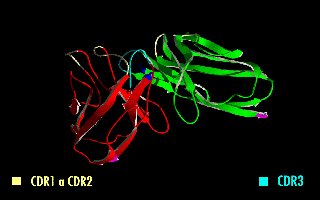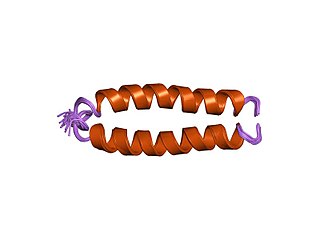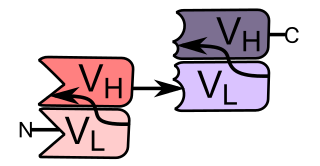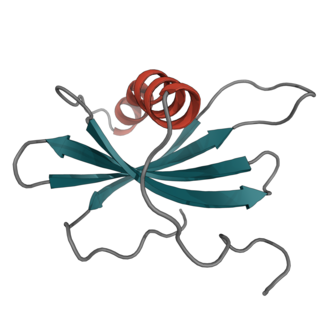
In immunology, antigens (Ag) are structures specifically bound by antibodies (Ab) or a cell surface version of Ab ~ B cell antigen receptor (BCR). The term antigen originally described a structural molecule that binds specifically to an antibody only in the form of native antigen. It was expanded later to refer to any molecule or a linear molecular fragment after processing the native antigen that can be recognized by T-cell receptor (TCR). BCR and TCR are both highly variable antigen receptors diversified by somatic V(D)J recombination. Both T cells and B cells are cellular components of adaptive immunity. The Ag abbreviation stands for an antibody generator.
An epitope, also known as antigenic determinant, is the part of an antigen that is recognized by the immune system, specifically by antibodies, B cells, or T cells. For example, the epitope is the specific piece of the antigen to which an antibody binds. The part of an antibody that binds to the epitope is called a paratope. Although epitopes are usually non-self proteins, sequences derived from the host that can be recognized are also epitopes.
Polyclonal antibodies (pAbs) are antibodies that are secreted by different B cell lineages within the body. They are a collection of immunoglobulin molecules that react against a specific antigen, each identifying a different epitope.
Affinity chromatography is a method of separating biochemical mixture based on a highly specific interaction between antigen and antibody, enzyme and substrate, receptor and ligand, or protein and nucleic acid. It is a type of chromatographic laboratory technique used for purifying biological molecules within a mixture by exploiting molecular properties.

A single-chain variable fragment (scFv) is not actually a fragment of an antibody, but instead is a fusion protein of the variable regions of the heavy (VH) and light chains (VL) of immunoglobulins, connected with a short linker peptide of ten to about 25 amino acids. The linker is usually rich in glycine for flexibility, as well as serine or threonine for solubility, and can either connect the N-terminus of the VH with the C-terminus of the VL, or vice versa.
This protein retains the specificity of the original immunoglobulin, despite removal of the constant regions and the introduction of the linker. The image to the right shows how this modification usually leaves the specificity unaltered.

Defensins are small cysteine-rich cationic proteins found in both vertebrates and invertebrates. They have also been reported in plants. They are, and function as, host defense peptides. They are active against bacteria, fungi and many enveloped and nonenveloped viruses. They consist of 18-45 amino acids including six to eight conserved cysteine residues. Cells of the immune system contain these peptides to assist in killing phagocytosed bacteria, for example in neutrophil granulocytes and almost all epithelial cells. Most defensins function by binding to the microbial cell membrane, and, once embedded, forming pore-like membrane defects that allow efflux of essential ions and nutrients.
Sulfation or sulfurylation in biochemistry is the enzyme-catalyzed conjugation of a sulfo group to another molecule. This biotransformation involves a sulfotransferase enzyme catalyzing the transfer of a sulfo group from a donor cosubstrate, usually 3'-phosphoadenosine-5'-phosphosulfate (PAPS), to a substrate molecule's hydroxyl or amine. Sulfation is involved in a variety of biological processes, including detoxification, hormone regulation, molecular recognition, cell signaling, and viral entry into cells. It is among the reactions in phase II drug metabolism, frequently effective in rendering a xenobiotic less active from a pharmacological and toxicological standpoint, but sometimes playing a role in the activation of xenobiotics. Another example of biological sulfation is in the synthesis of sulfonated glycosaminoglycans, such as heparin, heparan sulfate, chondroitin sulfate, and dermatan sulfate. Sulfation is also a possible posttranslational modification of proteins.

Fusion proteins or chimeric (\kī-ˈmir-ik) proteins are proteins created through the joining of two or more genes that originally coded for separate proteins. Translation of this fusion gene results in a single or multiple polypeptides with functional properties derived from each of the original proteins. Recombinant fusion proteins are created artificially by recombinant DNA technology for use in biological research or therapeutics. Chimeric or chimera usually designate hybrid proteins made of polypeptides having different functions or physico-chemical patterns. Chimeric mutant proteins occur naturally when a complex mutation, such as a chromosomal translocation, tandem duplication, or retrotransposition creates a novel coding sequence containing parts of the coding sequences from two different genes. Naturally occurring fusion proteins are commonly found in cancer cells, where they may function as oncoproteins. The bcr-abl fusion protein is a well-known example of an oncogenic fusion protein, and is considered to be the primary oncogenic driver of chronic myelogenous leukemia.

Anticalin proteins are artificial proteins that are able to bind to antigens, either to proteins or to small molecules. They are not structurally related to antibodies, which makes them a type of antibody mimetic. Instead, they are derived from human lipocalins which are a family of naturally binding proteins. Anticalin proteins are being used in lieu of monoclonal antibodies, but are about eight times smaller with a size of about 180 amino acids and a mass of about 20 kDa.

Bi-specific T-cell engagers (BiTEs) are a class of artificial bispecific monoclonal antibodies that are investigated for the use as anti-cancer drugs. They direct a host's immune system, more specifically the T cells' cytotoxic activity, against cancer cells. BiTE is a registered trademark of Micromet AG.
Affibody molecules are small, robust proteins engineered to bind to a large number of target proteins or peptides with high affinity, imitating monoclonal antibodies, and are therefore a member of the family of antibody mimetics. Affibody molecules are used in biochemical research and are being developed as potential new biopharmaceutical drugs. These molecules can be used for molecular recognition in diagnostic and therapeutic applications.
A microantibody is an artificial short chain of amino acids copied from a fully functional natural antibody. Microantibodies can stop viruses such as HIV from infecting cells in vitro.
Solitomab (INN) (MT110) is an artificial bispecific monoclonal antibody that is being investigated as an anti-cancer drug. It is a fusion protein consisting of two single-chain variable fragments (scFvs) of different antibodies on a single peptide chain of about 55 kilodaltons. One of the scFvs binds to T cells via the CD3 receptor, and the other to EpCAM as a tumor antigen against gastrointestinal, lung, and other cancers.
{{Drugbox
| IUPAC_name = N,N'-bis[3-{[5-(carbamimidoylamino)pentanoyl]amino}-2-[(3R)-pyrrolidin-3-yloxy]-5-(trifluoromethyl)phenyl]pyrimidine-4,6-dicarboxamide
| image = Brilacidin.svg
| width = 300px
| alt =
| image2 =
| width2 =
| alt2 =
| caption =
| tradename = None as of July 2012
| Drugs.com =
| MedlinePlus =
| licence_EU =
| licence_US =
| DailyMedID =
| pregnancy_AU =
| pregnancy_US =
| pregnancy_category=
| legal_AU =
| legal_CA =
| legal_UK =
| legal_US =
| legal_status =
| dependency_liability =
| routes_of_administration =
| bioavailability =
| protein_bound =
| metabolism =
| elimination_half-life =
| excretion =
| CAS_number = 1224095-98-0
| ATCvet =
| ATC_prefix = none
| ATC_suffix =
| ATC_supplemental =
| ChEMBL = 2219413
| UNII_Ref =
| UNII = I1679X069H
| PubChem = 25023695
| PubChemSubstance =
| IUPHAR_ligand =
| DrugBank =
| ChemSpiderID = 28651526
| KEGG = D10414
| ChEBI =
| synonyms =
| C=40 | H=50 | F=6 | N=14 | O=6
| molecular_weight = 936.9 g/mol
| SMILES = C1CNC[C@@H]1OC2=C(C=C C F)NC(=O)CCCCNC(=N)N
| StdInChI = 1S/C40H50F6N14O6/c41-39(42,43)21-13-25(57-31 5-1-3-9-53-37 48)33(65-23-7-11-51-18-23)27(15-21)59-35(63)29-17-30(56-20-55-29)36(64)60-28-16-22(40 46)14-26(34 66-24-8-12-52-19-24)58-32(62)6-2-4-10-54-38(49)50/h13-17,20,23-24,51-52H,1-12,18-19H2,(H,57,61)(H,58,62)(H,59,63)(H,60,64)(H4,47,48,53)(H4,49,50,54)/t23-,24-/m1/s1
| StdInChIKey = QPDYBCZNGUJZDK-DNQXCXABSA-N
| density =
| melting_point =
| melting_high =
| melting_notes =
| boiling_point =
| boiling_notes =
| solubility =
| specific_rotation =
| sec_combustion =
}}

Affimer molecules are small proteins that bind to target molecules with similar specificity and affinity to that of antibodies. These engineered non-antibody binding proteins are designed to mimic the molecular recognition characteristics of monoclonal antibodies in different applications. In addition, these affinity reagents have been optimized to increase their stability, make them tolerant to a range of temperatures and pH, reduce their size, and to increase their expression in E.coli and mammalian cells.

Alphabodies, also known as Cell-Penetrating Alphabodies or CPAB for short, are small 10 kDa proteins engineered to bind to a variety of antigens. Despite their name, they are not structurally similar to antibodies, which makes them a type of antibody mimetic. Alphabodies are different from many other antibody mimetics in their ability to reach and bind to intracellular protein targets. Their single chain alpha-helical structure is designed by computer modelling, inspired by naturally existing coiled-coil protein structures. Alphabodies are being developed by the Belgian biotechnology company Complix N.V. as potential new pharmaceutical drugs against cancer and autoimmune disease. In 2012, a collaboration agreement was signed with Monsanto to develop the technology for agricultural applications as well.
In the medical field of immunology, nanoCLAMP affinity reagents are recombinant 15 kD antibody mimetic proteins selected for tight, selective and gently reversible binding to target molecules. The nanoCLAMP scaffold is based on an IgG-like, thermostable carbohydrate binding module family 32 (CBM32) from a Clostridium perfringens hyaluronidase. The shape of nanoCLAMPs approximates a cylinder of approximately 4 nm in length and 2.5 nm in diameter, roughly the same size as a nanobody. nanoCLAMPs to specific targets are generated by varying the amino acid sequences and sometimes the length of three solvent exposed, adjacent loops that connect the beta strands making up the beta-sandwich fold, conferring binding affinity and specificity for the target.











